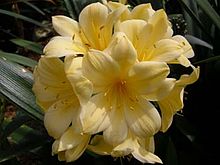- Clivia
-
Clivia 
Clivia miniata Scientific classification 
Kingdom: Plantae clade: Angiosperms clade: Monocots Order: Asparagales Family: Amaryllidaceae Subfamily: Amaryllidoideae Genus: Clivia
Lindl.Species C. caulescens
C. gardenii
C. miniata
C. mirabilis
C. nobilis
C. robustaClivia (
 /ˈklaɪviə/)[1] is a genus of monocot flowering plants native to southern Africa. They are from the family Amaryllidaceae, subfamily Amaryllidoideae.[2] Common names include Kaffir lily and bush lily.
/ˈklaɪviə/)[1] is a genus of monocot flowering plants native to southern Africa. They are from the family Amaryllidaceae, subfamily Amaryllidoideae.[2] Common names include Kaffir lily and bush lily.They are herbaceous evergreen plants, with green, strap-like leaves. Flowers are bell-shaped flowers on a stalk above the foliage, and they are can be any color of orange, redish orange, bronze orange, peach,greenish yellow ,yellow[3][not in citation given] There are a number of variegated leaf patterns, including light of Buddha, and akebono. Leaves can be narrow or very broad.
Contents
Species
Of the six known species, Clivia miniata is the most widely cultivated, and hybrid varieties with flowers ranging from deep red-orange to pale yellow have been bred by growers. Yellow plants can belong to one of two different groups which breed true for colour, producing seedlings with unpigmented stems and all yellow flowers when mature. When yellows from different groups are crossed, seedlings with pigmented stems occur and the resulting flowers are orange.[4][4] ref Marriot, Helen, Clivia News, Volume 19, Number 4, quarterly newsletter of the clivia society, page24
C. miniata, C. gardenii, C. robusta and C. caulescens seedlings flower after four to five years. C. nobilis will flower after seven or eight years. It is reported that C. mirabilis also takes about 6 years to flower.
Specimens were gathered by British explorers William Burchell and John Bowie in 1815 and 1820, respectively. Clivia nobilis became the first named species when in 1828 the Kew botanist John Lindley named it in honor of Lady Charlotte Florentia Clive, Duchess of Northumberland (1787–1866)[5] (wife of Hugh Percy, 3rd Duke of Northumberland), who was for a time the governess of the future Queen Victoria.[6][7][8]
Blooming season
Typically C. miniata, C. noblis and C. caulescens flower in late winter and spring, with out of season flowers for C. miniata occurring almost anytime. C. gardenii and C. robusta flower in autumn. Interspecific hybrids can flower almost anytime of the year depending on climate and flowering pattern of hybrids' parentage.[9]
Culture
Water regularly in summer, but avoid overwatering. From autumn till late winter maintain a resting period, keep plants almost dry at 46-50 degrees F (8-10 degrees C). From spring fertilize every 14 days.
When new leaves grow and the flower shaft develops, mist. Wipe leaves occasionally with a damp cloth if dusty from indoor culture. Repot plants yearly or biyearly in all-purpose potting medium or coco husks,offsets may be removed when repotting, but allow offset to be sufficiently developed to successfully grow on independently.
Seeds need to be cleaned and germinate on top of moist material in high humidity container, furry root develops and one leaf emerges. Continue to grow on.
Pests and diseases include scale insects, mealy bug, and rot.
Tips
If your Clivia does not bloom, it may be because the cool resting period has not been provided, the amount of water was increased too soon in the spring (the flower stalk should be at least 6 inches [15 cm] high), or watering was insufficient during the main growth phase of the flower stalk. Also, it takes 4–6 years for the first flowering.
Australia
Clivia are popular as garden plantings with many public mass plantings of older original miniatas and interspecifics. There are also groups of hobbyists growers who meet regularly to learn more and display newer improved speciems. In Melbourne, the Melbourne Clivia Group meet to share information and promote the culture of clivia. Toowoomba in Queensland also has a club, where a magnificent Spring Carnival of Flowers occurs.
Toxicity
Clivias contain poisonous alkaloids. [10]
Notes and references
- ^ Western Garden Book. Sunset Books. 1995. pp. 606–607. ISBN 0376038519.
- ^ Stevens, P.F. (2001 onwards), Angiosperm Phylogeny Website: Asparagales: Amaryllidoideae, http://www.mobot.org/mobot/research/apweb/orders/asparagalesweb.htm#AllAma
- ^ "Clivias". http://greenplants.ca/clivia_care.html. Retrieved 2009-12-06.
- ^ a b Marriot, Helen, Clivia News, Volume 19, Number 4, quarterly newsletter of the clivia society, page24
- ^ Clivia San Marcos Growers. URL accessed April 8, 2006.
- ^ Clivia Forum. A Clivia discussion Forum.
- ^ Clivia Indonesia. Indonesia Clivia Forum.
- ^ Clivia Base. South African Clivia Website.
- ^ Marriot, Helen, Clivia News, Volume 19, Number 4, quarterly newsletter of the Clivia Society, page 24.
- ^ Notes on poisoning: Clivia miniata
Categories:- Amaryllidaceae genera
- Garden plants of Southern Africa
- Flora of South Africa
- Amaryllidoideae
Wikimedia Foundation. 2010.
